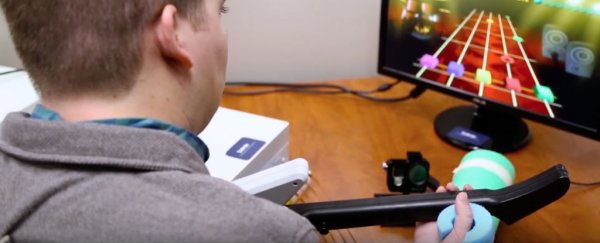A 24-year-old quadriplegic man has regained his ability to pick up objects, stir liquids, swipe a credit card, and yep, play Guitar Hero, thanks to a new brain implant that allows him to control the muscle movement in his arms, hands, and fingers with just his thoughts.
The world-first device, called NeuroLife, allows the brain to communicate directly with muscles in paralysed limbs - effectively bypassing the damaged spinal cord altogether. And as you can see in the video below, the results are pretty freaking cool.
"In the 30 years I've been in this field, this is the first time we've been able to offer realistic hope to people who have very challenging lives," says one of inventors, Jerry Mysiw from Ohio State University. "What we're looking to do is help these people regain more control over their bodies."
The NeuroLife device - which is basically a pea-sized computer chip - was implanted into Ohio man, Ian Burkhart's, brain during a 3-hour surgical procedure back in 2014. Burkhart has been paralysed from the shoulders down for the past six years, following a severe diving accident in 2010.
Once in place, complex algorithms in the chip learn and decode specific thoughts and neural signals related to muscle control, and instructions are then transmitted to a special sleeve worn by the patient in less than a tenth of a second. Sensors in the sleeve stimulate the muscles in the paralysed limbs to move according to those instructions.
But programming the chip to know which types of brain signals to interpret or ignore, and then which electrodes on the sleeve to stimulate and when, was no easy task - researchers from Ohio State and Battelle Memorial Institute have been figuring this out for over the better part of a decade. The Ohio State team explains:
"For example, Burkhart uses different brain signals and muscles to rotate his hand, make a fist or pinch his fingers together to grasp an object. As part of the study, Burkhart worked for months using the electrode sleeve to stimulate his forearm to rebuild his atrophied muscles so they would be more responsive to the electric stimulation."
Having worked with the device for two years now, Burkhart is showing incredible progress, starting with simple grasping motions back in 2014, and advancing to more sophisticated movements such as picking up a spoon and stirring a drink with it, or strumming chords on a guitar.
"During the last decade, we've learned how to decipher brain signals in patients who are completely paralysed and now, for the first time, those thoughts are being turned into movement," said one of the team, Chad Bouton, formerly of Battelle. "Our findings show that signals recorded from within the brain can be re-routed around an injury to the spinal cord, allowing restoration of functional movement and even movement of individual fingers."
The results have been published in Nature today, and the team has announced that a second candidate will begin the study next summer. They say the primary goal of the research is to upgrade it to a wireless system and make it readily available to all kinds of patients dealing with spinal injuries.
For Burkhart, it hasn't been an easy couple of years learning how to wrangle this new device, but he wouldn't have it any other way. "I just kind of think that it's my obligation to society," he said. "If someone else had an opportunity to do it in some other part of the world, I would hope that they would commit their time so that everyone can benefit from it in the future."
The future just keeps on looking brighter and brighter for people like Burkhart, and we can't wait to see how they progress.
